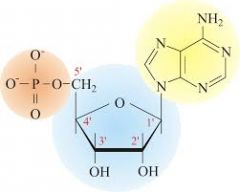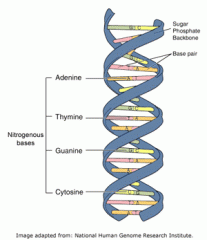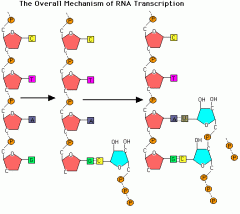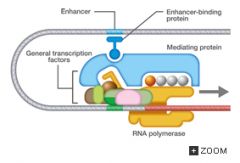![]()
![]()
![]()
Use LEFT and RIGHT arrow keys to navigate between flashcards;
Use UP and DOWN arrow keys to flip the card;
H to show hint;
A reads text to speech;
30 Cards in this Set
- Front
- Back
|
Nucleotides
|

DNA's subunits. Consists of three components: a 5-carbon sugar, a base, and one or more phosphate groups. The 5-carbon sugar and phosphate groups form the backbone of the molecule, with each sugar linked to the phosphate group of the neighbouring nucleotide. The bases sticking out from the sugar give each nucleotide its chemical identity. Each strand of DNA consists of an enormous number of nucleotides linked one to the next.
Phosphate group attaches to the 5' carbon. Base is attached to 1' carbon. |
|
|
Purines
|
A nitrogenous base. Double-ring structures, adenine and guanine.
A--T G---C |
|
|
Pyrimidines
|
A nitrogenous base. Single-ring structures, thymine and cytosine.
T--A C---G |
|
|
Nucleoside
|
Combination of sugar and base
|
|
|
Phosphodiester bond
|
Covalent bond that connects one nucleotide to the next. Connects the 3' carbon of one nucleotide to the 5' carbon of the next nucleotide through the 5' phosphate group. It gives the DNA molecule polarity. The 5' end of the molecule differs from the 3' end of the molecule.
|
|
|
DNA molecule form
|

DNA is a double helix. Bases form hydrogen bonds with other bases, connecting two single stranded DNA molecules and making a double stranded DNA molecule that is helical. A forms two hydrogen bonds with T and G forms three hydrogen bonds with C.
|
|
|
Antiparallel
|
DNA strands in a double helix are antiparallel, which mean they run in opposite directions. So the 3' end of one strand is matched wight the 5' strand of the other strand, and vice versa.
|
|
|
Base stacking
|
Interactions between bases in the same strand. It is a stabilizing force and it occurs because the non polar, flat surface of the bases tend to group together away from the water molecules, and hence stack on top of one another as tightly as possible.
|
|
|
DNA Base Sequences
|
There is no restriction of DNA base sequences, which suggested that genetic information in DNA could be encoded in the sequence of bases along the DNA.
|
|
|
Chargaff's Rule
|
# of T = # of A
# of G = # of C G + A = C + T |
|
|
Supercoils
|
DNA molecules in prokaryotic cells do this. Happens when a circular molecular coils upon itself. Caused by enzymes known as topoisomerases tag cleave, partially unwind, and reattach a DNA strand, which puts strain on the DNA double helix. Supercoils then relieve the strain and help to preserve the 10 base pairs per turn in the double helix.
|
|
|
Chromosome
|
How DNA is packaged in the nucleus. Most DNA is linear in eukaryotic cells, and they form a chromosome.
|
|
|
Chromatin
|
A complex of DNA, RNA, and proteins that gives their structure.
|
|
|
Nucleosome
|
A beadlike repeating unit of histone proteins wrapped with DNA making up the 10-nm chromatin fibre
|
|
|
Histone
|
A protein that is rich in the positively charged amino acids lysine and arginine, which enables them to form ionic bonds with the negatively charged sugar-phosphate backbone of DNA. DNA wraps twice around this
|
|
|
Evolutionarily Conserved
|
Very similar in sequence from one organism to the next. Indicates that they serve an essential function and therefore have not changed much over time.
|
|
|
Ribosomes
|
Where proteins are synthesized. But since ribosomes contain no DNA, there must be an intermediary molecule by which the genetic information is transferred from the DNA to the ribosome. This turned out to be RNA.
|
|
|
Brenner, Jacob, & Meleson Experiment
|
Proved that RNA was the intermediate step from DNA to proteins. Used a virus that hijacks the cellular machinery to produce viral proteins. Shortly after infection and before viral proteins were made, the infected cells produce a burst of RNA molecules that correspond to the viral DNA.
|
|
|
RNA World Hypothesis
|
Since RNA has properties of both DNA & proteins, many believe that the first information storage molecule was RNA. It is also supported by the fact that RNA is essential in key cellular processes, including DNA replication, transcription, and translation.
|
|
|
If RNA was the original information storing molecule, why do cells now use DNA and proteins to carry out other cellular processes?
|
DNA is much more stable than RNA and proteins are more versatile, so it makes sense that life evolved from and RNA-based world to the one we live in now.
|
|
|
Differences between RNA & DNA
|

|
|
|
RNA Transcript
|

A piece of RNA that is complementary in sequence to the template DNA according to the base paring rules. Transcript is produced by polymerization of ribonucleoside triphosphate
|
|
|
RNA polymerase
|
Enzyme that carries out the polymerization. Adds successive nucleotides to the 3' end of the growing transcript. This means that the RNA transcript grows in the 5' to 3' direction
|
|
|
Non-template Strand
|
Stand of DNA that is not be transcribed
|
|
|
Promoters
|
Regions of DNA that typically have a few hundred base pairs where RNA polymerase and associated proteins bind to the DNA duplex. Many eukaryotic promoters contain a sequence similar 5'-TATAAA-3', which is known as the TATA box. The first nucleotide to be transcribed is generally around 25 base pairs from the TATA box
|
|
|
Terminator
|
Transcription continues until the RNA polymerase encounters a terminator sequence. It stops here and the transcript is released.
|
|
|
Housekeeping Genes
|
Products needed at all times in the cell, so transcription takes place continually.
|
|
|
General Transcription Factors
|
At least six of these are required at the promoter region for transcription to occur. They attract the RNA polymerase and its associated proteins to the site. The PNA polymerase complex responsibly for transcription of protein-coding genes is called Pol II
|
|
|
Transcriptional Activator Protein
|

Needed to start transcription. They bind to a specific DNA sequence known as an enhancer, and recruit a mediator complex of proteins which in turn interacts with the Pol II complex, and transcription begins.
|
|
|
Transcription Bubble
|
Separation in the DNA double helix so transcription can take place.
DNA enters the RNA Pol II through channel and is threaded out another channel via a structure that splits the strands apart, forming a bubble, so that ribonucleotides can assemble on the template strand. Another part of the enzyme forces the growing RNA out a different channel. As DNA travels through the RNA polymerase, the RNA transcript is elongated at the active site of the enzyme. |

